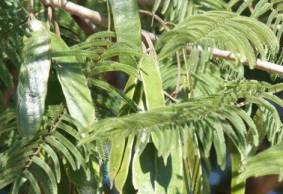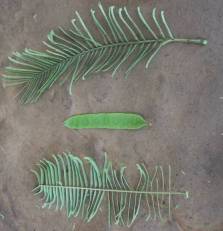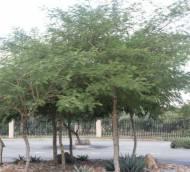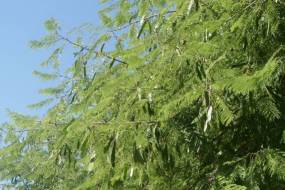Senegalia polyacantha subsp. campylacantha
Senegalia polyacantha (Willd.) Seigler & Ebinger subsp. campylacantha (Hochtst. ex. A Rich.) Kyal. & Boatwr.
Family: Fabaceae
Common names: white-stem thorn (Eng.); witdoring (Afr.); mooka, mpho-kamagwa (Northern Sotho); xigatlu, nkowankowa (Tswana)?; tshikwalo (Venda); umnga (Xhosa)
SA Tree No: 180
Introduction
This is one of the most attractive acacias in Africa. It often has one stem with branching commencing fairly high up, and a neat flattish crown. It has an attractive, whitish stem when mature, with striking light yellow flowers that are sweetly scented.

Description
Description
The white-stem thorn is a large, erect tree that grows to an average height of 10-15 m, exceptionally large trees may reach a height of 25 m. The stem of younger trees appears yellowish with papery bark and persisting prickles. As it gets older, the bark gets smoother and whitish grey, with bark flakes sometimes present. Young branches are covered in silvery hairs and the whole tree is covered in dark brown to black hooked thorns in pairs.

The leaves are twice compound with 14-35 pairs of pinnae and 20-60 leaflets per pinna. Leaves are fairly large and arranged singly along the shoots. The upper surface of the leaves is darker than the underside, and mostly with hairs on the margins and on the leaf stalk. The flowers that appear from September to December are light yellow to cream. The flowers as well as the seedpods are borne in spikes, which arise from the nodes. They can appear singly or in clusters of up to four and are sweetly scented.

The seed pods are flat and appear shiny green, turning to a light brown colour as they ripen and then dry out. The number of seeds per pod varies from 3 to 10 and they are also fairly flattened, and dark brown when ripe.
Distribution and habitat
Distribution description
The tree often grows in the moist, subtropical bushveld of Africa, usually in alluvial soils near rivers. It is widespread in tropical Africa, occurring from Gambia to Ethiopia and southwards to Kenya and Zimbabwe. It has a limited distribution in South Africa, being found only in Limpopo. Some specimens can be found in the Kruger National Park, in the Punda Maria and Pafuri areas.
Derivation of name and historical aspects
History
The genus name refers to Senegal, a country in West Africa. The whole tree is covered by dark brown to black hooked thorns that are paired. On the stem they are shorter and more rigid than on the branches. For this reason, the tree was named polycantha, which means many thorns. The subspecies name, campylacantha means curved thorns.
Senegalia polyacantha can be confused with S. caffra and Vachellia sieberiana, but can be distinguished by the following features:
Senegalia polyacantha is large tree with straight trunk and a flat neat crown, whereas S. caffra is a medium sized tree with a curved and knotted trunk and a roughly branching crown. S. polyacantha has curved, paired spines and flowers arranged in spikes whereas Vachellia sieberiana has straight, paired spines and balls of flowers.

Uses
Use
The white-stem thorn tree yields gum that is normally used in confectionery and as an adhesive, while the bark is used in tanning. The roots and possibly bark are used for medicinal and magical purposes. With its strong odour, the root appears to be avoided by animals. It is placed among the rafters of the house to repel snakes. In rural areas, the root is placed on crossing areas in the rivers to ward off crocodiles. Root infusion is used to treat snakebites, and also to bathe children who are restless at night. The tree is also a larval food plant for the butterfly Anthene crawshayi crawshayi.

Growing Senegalia polyacantha subsp. campylacantha
Grow
The white-stem thorn tree can be propagated from seeds, which may be immersed in boiling water and soaked overnight to soften the hard, outer seed coat. They may then be sown in well-drained, sifted potting soil and placed in a warm place until they germinate. Germination may take between 1 and 4 weeks. The seedlings may be pricked out at the two-leaf stage or left until they are larger and more established. Care should be taken not to damage the delicate root system. They may then be planted in individual containers and kept in full sun or dappled shade and watered well. Saplings may be ready to be planted out after two to four years, depending on the size required.
This is a beautiful specimen that gives height in a medium to large garden; as this is a large tree, it that is not suitable for the small home garden. It does well planted alone or in groups with other trees. With its height, it may be an excellent street tree.
References
- Coates Palgrave, M. 2002. Keith Coates Palgrave Trees of southern Africa. Struik, Cape Town.
- Schmidt, E., Lötter, M. & McCleland, W. 2002. Trees and shrubs of Mpumalanga and Kruger National Park. Jacana, Johannesburg.
- Smit, N. 1999. Guide to the acacias of South Africa. Briza Publications, Pretoria.
- Venter, F. & Venter, J-A. 1996. Making the most of indigenous trees. Briza Publications, Pretoria.
Credits
Mhlonishwa D. Dlamini
Walter Sisulu National Botanical Garden
June 2005
Plant Attributes:
Plant Type: Tree
SA Distribution: Limpopo
Soil type: Loam
Flowering season: Spring, Early Summer
PH: Neutral
Flower colour: Cream
Aspect: Full Sun
Gardening skill: Easy
Special Features:
Horticultural zones









Rate this article
Article well written and informative
Rate this plant
Is this an interesting plant?
Login to add your Comment
Back to topNot registered yet? Click here to register.